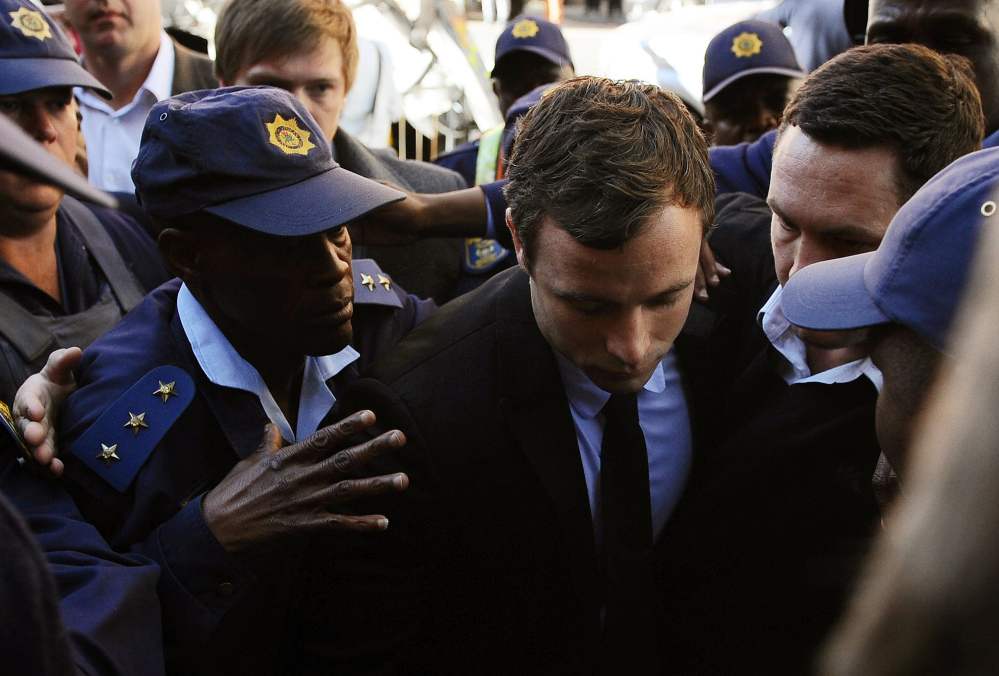JOHANNESBURG — With his past triumphs now tarnished because he shot to death his girlfriend, Oscar Pistorius on Monday will enter court to be confronted with the jarring possibility that he will be sent to prison for at least 25 years.
For the champion runner without legs, who trained himself to overcome all obstacles, nothing else matters now but beating the murder charge against him. Pistorius’ family said Saturday that their focus is only on the trial. If found guilty, Pistorius’ entire life story will be recast.
When Pistorius walks on his prosthetics into North Gauteng High Court for the start of his trial, seemingly little remains of the Blade Runner, the double amputee who ran alongside the world’s best and inspired many by overcoming the loss of his legs before he was a year old.
Now, the 27-year-old Olympian must fight allegations that, in a rage, he intentionally shot at girlfriend Reeva Steenkamp four times through a toilet door, killing her. Prosecutors allege that Pistorius then lied extensively about the shooting, throwing doubt on everything the world thought it knew about him.
Pistorius’ life is up for debate, not just the events in the early hours of Valentine’s Day last year.
Prosecutor Gerrie Nel called Pistorius a man “willing and ready to fire and kill” as the state charged him with premeditated murder. Prosecutors say there was “a measure of preparation” in the way he killed Steenkamp after the couple argued loudly at his home.
Pistorius gives a totally different story, saying he was terrified in the mistaken belief that there was a dangerous intruder in his home about to hurt him and the woman he says he loved dearly.
“I knew I had to protect Reeva and myself,” Pistorius says in an 11-page affidavit, his only testimony so far. She died in his arms, he says.
The state’s account makes Pistorius out to be a cold and calculating killer; his own description is of a disabled man on his stumps and afraid who made a terrible mistake. Which version is true? It is the question that will underline Pistorius’ entire trial.
It’s a case where forensic and ballistic experts and criminal psychologists will feature, and where a toilet door, bullet trajectory, blood spatter, cellphone records and the debate over gun ownership and South Africa’s violent crime problem will play a part, all revolving around a famous figure. Large parts of the trial will be broadcast live from Courtroom GD in Pretoria’s high court building.
Pistorius’ mind-set and intention in the hours leading up to 3 a.m. last Feb. 14 is what ultimately matters. What clues do we have from him?
His life has been tumultuous and touched by tragedy before. Pistorius emerged from the hardship of his disability and the sudden death of his mother, the biggest influence on him, to become a role model for many. He was banned from competing against the able-bodied because of his carbon fiber running blades but he got that overturned. He was a boundary-breaking athlete who tested the world’s preconceptions of what disabled meant and did it with apparent humility and decency.
There were flashes of something else though: A speedboat crash in early 2009 that left him in hospital with serious facial injuries amid allegations of drinking and reckless behavior. Later that year, Pistorius was arrested after a female guest at a party at his house made a complaint of assault against him. Charges weren’t pursued.
Maybe most telling, two years ago when he was reportedly with friends in a car pulled over by traffic police and, after an altercation, he allegedly responded as they drove away by shooting his gun angrily out the sunroof. Prosecutors will add two counts relating to him firing a gun in public to his murder and illegal possession of ammunition charges at trial. One of them is believed to be that sunroof incident.
Did Pistorius reach for his 9mm pistol again when angry on Valentine’s Day, prosecutors will ask.
Perhaps the Pistorius that walked to the bathroom of his upscale home gun in hand was someone between the two extremes offered by the prosecution and the defense.
Guns were one of Pistorius’ passions, but he also says they were his protection. In South Africa, a country with a high rate of violent home invasions, Pistorius is not alone in owning a gun for self-defense. He previously spoke of his fear of crime. But Pistorius didn’t obey gun-owners’ strict guidelines when he fired bullets through a door without seeing who was on the other side. Maybe he was fearful, but he was also possibly negligent.
“A reasonable man most probably would not have fired four shots through the door,” Marius du Toit, a defense attorney and former South Africa state prosecutor not involved in the case, told The Associated Press. “His actions were definitely not reasonable and I think that’s his biggest problem.”
A murderer, a hero who made a mistake or someone caught in the middle, afraid but also too fast to fire. They are options that must be weighed by Judge Thokozile Masipa when she decides whether to convict on murder, acquit, or find Pistorius guilty of a lesser offense of negligent killing.
Pistorius’ ex-girlfriend Samantha Taylor told a South African newspaper a few months before the shooting: “Oscar is certainly not what people think he is.”
Only the trial verdict will decide what he is.
Send questions/comments to the editors.



Comments are no longer available on this story